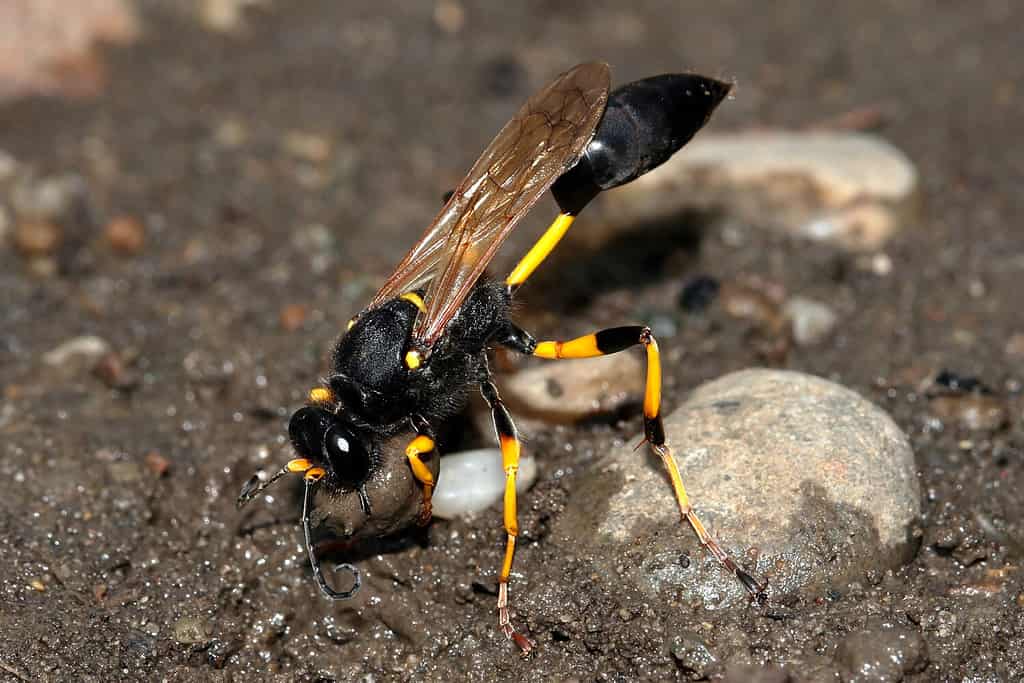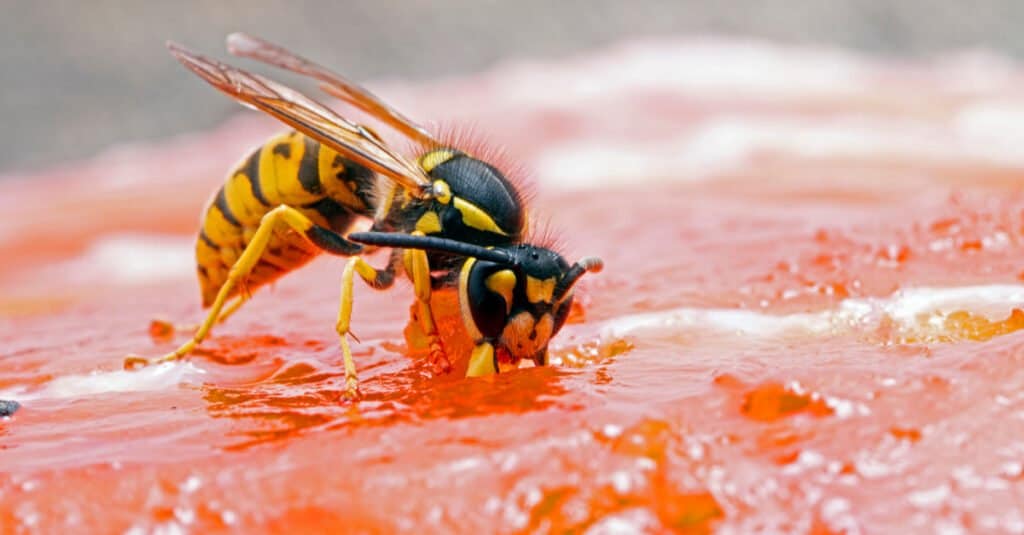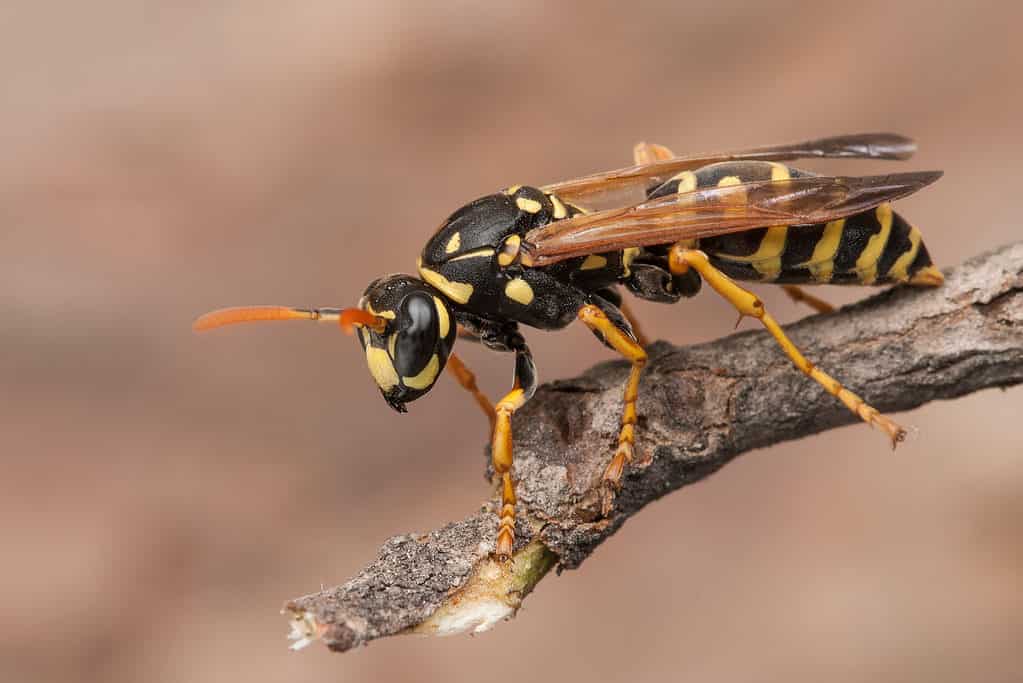There are many kinds of insects that live in Florida, and several kinds of wasps are among them. Most of these wasps don’t pose much of a threat to people, but a small number of them can inflict a painful sting or even kill. People in Florida can take steps to avoid being stung by wasps if they know what kinds of wasps are most common in the state and how painful their stings are.
In this regard, it’s essential to be informed about the common types of wasps and their sting severity to stay safe. So, let’s take a closer look at 5 Florida wasps ranked by the pain of their sting according to the Schmidt Pain Index (which we will discuss below).
Types of Wasps In Florida Ranked By the Pain of their Sting:
1. Mud Dauber Wasps:

Mud daubers are solitary wasps that build their nests out of the mud.
©Geza Farkas/Shutterstock.com
Mud Dauber Wasps live by themselves and can be found all over Florida, especially in rural and suburban places. Their name comes from the fact that they build mud nests to keep their eggs safe and warm. Mud Daubers are usually not aggressive and will only sting if they feel threatened. They are helpful because they eat spiders, which they stun and then feed to their young.
Schmidt Pain Index – Level 1
Although there isn’t a specific rating for mud dauber wasps on the Schmidt Pain Index, some sources report that their sting typically falls on the lower end of the pain scale. It is often given a rating of around 1 on a scale of 0 to 4, which is considered to be relatively mild. This is just a general consensus, and individual experiences may vary.
2. Yellow Jackets:

Yellowjackets are common in Florida.
©Ernie Cooper/Shutterstock.com
Yellow jacket wasps are a type of wasp that is common in Florida, especially in the summer and fall. They are thin wasps with black and yellow lines, and their painful stings are well-known. Yellow jackets are different from other types of wasps because they are social insects that live in nests that can hold thousands of them. They are also violent and will fight to protect their nests, which can be dangerous for people who are close by. Yellow jackets eat a wide range of things, like insects, nectar, and other food sources.
Schmidt Pain Index – Level 2
Yellow jackets are ranked at around 2.0 on the Schmidt Pain Index, indicating that their sting can cause a relatively painful sensation that can last for up to 10 minutes. It’s important to keep in mind that individual experiences may vary and that if you are stung and experience severe symptoms or signs of an allergic reaction, seek medical attention immediately.
3. Bald-Faced Hornets:

Bald-faced Hornets are social wasps that build communal nests by chewing wood to create a sticky thin pulp.
©Ernie Cooper/Shutterstock.com
Bald-faced hornets are a type of wasp that lives in most of North America, including Florida. They are a type of yellow jacket wasp and have a black-and-white color pattern. Bald-faced hornets are social insects that live in groups and make paper nests that they connect to trees, bushes, or buildings. Adult colonies can have up to 400 workers living in them. The nests are usually gray and can be quite big. Bald-faced hornets are known to defend their homes aggressively and will sting more than once if they think there is a threat.
Schmidt Pain Index – Level 2
The bald-faced hornet’s sting is ranked at around 2.0 on the Schmidt Pain Index, indicating that it can cause a relatively painful sensation that can last for several minutes.
4. Cicada Killer Wasps:

Cicada killer wasps sustain themselves by feeding on cicadas and other insects.
©samray/Shutterstock.com
Cicada Killer Wasps are a type of solitary wasp that lives in Florida and other parts of North America. The females can grow up to 40 mm long, which is a lot for a bug. These wasps are usually black and yellow, and they are known for eating cicadas. Even though they may look scary, they are usually not mean to people and will only sting if they feel threatened. Cicada Killer Wasps are actually good because they help keep cicadas, which can hurt trees and other plants, in check.
Schmidt Pain Index – Level 2.5
the cicada killer wasp is ranked at around 2.5 on the Schmidt Pain Index, indicating that its sting can cause a relatively painful sensation.
5. Paper Wasps:

Paper wasps are social wasps that live in Florida.
©Pavel Krasensky/Shutterstock.com
Paper wasps are a type of social wasp that lives in Florida and other parts of the United States. They are usually brown or reddish brown, and their bodies are long and thin, with thin waists. Paper wasps usually make open nests in the shape of an umbrella. These nests are made of a papery material that the wasps make by chewing on wood fibers. Most of the time, you can find these nests hanging from leaves, tree branches, or other places.
Paper wasps are known for being defensive, and they will sting if they feel threatened or if someone messes with their nests. Like other social wasps, Paper Wasps help keep other insect populations in check, which is why they are often thought to be helpful.
Schmidt Pain Index – Level 3
the paper wasp’s sting is ranked at around 3.0 on the Schmidt Pain Index, indicating that it can cause a relatively painful burning sensation.
How Does the Schmidt Pain Index Work?

Insect stings can be incredibly painful, or very mild according to the Schmidt Pain Index.
©namtipStudio/Shutterstock.com
The Schmidt Pain Index was made by entomologist Justin Schmidt. Schmidt wrote down his own experiences with stings from venomous insects and wrote about how painful each one was. The scale goes from 0 to 4, with 0 meaning that there is no pain and 4 meaning that it hurts the most.
The index has also been used to compare different kinds of insects and how toxic their venom is. But it’s important to remember that everyone’s pain is different, and the index is meant to be used as a general guide, not as the only way to measure pain.
The photo featured at the top of this post is © scubaluna/Shutterstock.com
Thank you for reading! Have some feedback for us? Contact the AZ Animals editorial team.






